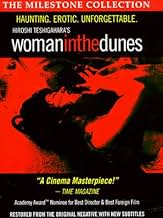Um entomologista de férias é forçado pelos moradores locais de uma vila a viver com uma mulher cuja função na vida é escavar areia para eles.Um entomologista de férias é forçado pelos moradores locais de uma vila a viver com uma mulher cuja função na vida é escavar areia para eles.Um entomologista de férias é forçado pelos moradores locais de uma vila a viver com uma mulher cuja função na vida é escavar areia para eles.
- Indicado a 2 Oscars
- 11 vitórias e 3 indicações no total
Avaliações em destaque
The film reflects existential, not Zen, themes, and belongs with Camus and Beckett. Life is meaningless in this pit, there is no escape, and the day to day toil is not only a struggle, but absurd and nonsensical. There is clearly a parallel being drawn to the bugs being buried in the sand as well as struggling futilely in test tubes earlier in the movie. It also reflects man's cruelty in the bugs pinned on boards to the forced labor. The scene towards the end, where the villagers look impassively down through masks and glasses with the taiko drums pounding, demanding a lewd display, is chilling.
There are a couple of very raw erotic scenes between Okada and Kishida, heightened by the conditions they find themselves in, and notably occurring as one wipes the other down. In trying to free ourselves of this painful world and the grime it coats us with, if even for only moments, we turn to the embrace of another, and take comfort in carnal moments. It's beautiful and somewhat pathetic at the same time. Okada also experiences a moment of transcendence when he invents a water pump, and sees it as a higher achievement than his original goal of discovering a new species of beetle and having it named after him. There is humanity again, displaying intelligence in improving his lot, and vanity. It's a somewhat grim film, but there is solace in these things. Definitely worth watching.
The story involves an amateur entomologist captured in a giant sand pit somewhere on the coast of a small Japanese island. He tries to escape but a mysterious woman and some nasty villagers keep pulling him back in.
Despite being made in the early sixties this film still packs a dose of eroticism that most contemporary filmmakers pray to achieve. The black and white cinematography is absolutely haunting (watch out for poor video copies which are way too dark, there is a new DVD out which shows what the original print intended)
This is about as close as you can get to a perfect film. There is nothing that could ever be improved upon.
The psychology between the two is excellently depicted. The tension is intensified trough images of sweaty skin and running sand. The cinematographer is a master in filming this. Lots of black. Editing also is sharp and very well done. Sound is minimal and fits the images' bleak and deserted dunes.
Much can be said about this movie, it is one for repeated viewings for sure.
Niki immediately questions the woman, as to why she would live in such a desolate place, in a ramshackle house where the sand is constantly flowing through holes in the roof and he is amazed to find that her nightly Sisyphean task involves filling baskets with sand that has blown into the pit and having it hoisted up by the locals. After feeding him, the woman tells him he doesn't have to help on his first night here, he finds this a curious statement as he is only staying one night? The truth behind the pit is soon revealed as Niki finds that there is no way out of the pit, the rope ladder having been removed by the locals.
Teshigahara is perhaps best known for his surreal and existential works, Woman in the Dunes fits right into this category. The setting of the sand dunes with the blinding sun gives the film an otherworldly dreamlike quality, with continuing rivers of sand also adding to this quality. The revelation that he is being kept captive is also a rather scary and intriguing, the film traces Niki's mixed emotions of anger and aggression, his denial of his captors, his change of heart and the fact he would stop at nothing to get the merest of rewards from them. His transformation is complete as he himself turns into a captor, of the woman that he now shares his life with.
The film is an epic at almost 2 ½ hours, its pace is incredibly slow but strangely it still doesn't feel that long, this viewer being drawn in to the complexities of the film. There's also a very sensual and sexual subtext, with the burning heat and little to do during the day and with the woman's recommendation that they sleep naked because the sand will chaff them, it is inevitable that sexual liaisons will happen and they do, sometimes it rough and ready and they wrestle each other, sometimes its sensuous as they provocatively wash the sand from each other in some very intimate moments.
Woman of the Dunes I have heard is full of subtext and hidden meanings, some are contradictory to the writer and directors visions so its hard to tell exactly on this my first viewing, exactly what they are so I will not even try to do so, I'll just sit back and let the film wash through my mind again and maybe it will all fall into place. The ending is controversial I would say, I can imagine it causes divide amongst those who have seen it, but in the context of the surreal setting and qualities of the film, I think it suits it fine, if nothing else it will get you talking about it, I think it's a film ripe for over analysis, so again I won't.
Você sabia?
- CuriosidadesFor this film, Hiroshi Teshigahara became the first Japanese director to be nominated for an Oscar for directing.
- Erros de gravaçãoThe beard of teacher Jumpei is not growing, despite him even complaining about no opportunity to shorten it.
- Citações
Entomologist Niki Jumpei: The certificates we use to make certain of one another: contracts, licenses, ID cards, permits, deeds, certifications, registrations, carry permits, union cards, testimonials, bills, IOUs, temporary permits, letters of consent, income statements, certificates of custody, even proof of pedigree. Is that all of them? Have I forgotten any? Men and women are slaves to their fear of being cheated. In turn they dream up new certificates to prove their innocence. No one can say where it will end. They seem endless.
- ConexõesFeatured in Music for the Movies: Tôru Takemitsu (1994)
Principais escolhas
- How long is Woman in the Dunes?Fornecido pela Alexa
Detalhes
- Data de lançamento
- País de origem
- Idioma
- Também conhecido como
- Woman in the Dunes
- Locações de filme
- Empresas de produção
- Consulte mais créditos da empresa na IMDbPro
- Tempo de duração2 horas 27 minutos
- Cor
- Proporção
- 1.37 : 1
Contribua para esta página



























